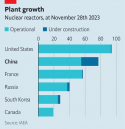One thing that I have just realized is that for both wind and solar, the best sites have likely already be taken years ago, be it for ease of transport, solar/wind availability or other factors. Make sense right, the industry is new and just starting out, so make sense to grab the best sites that you can for your first couple of projects. Especially for wind, since wind speeds and availability can vary so much from location to location. So that means that a lot of the best spots for wind and solar are currently being used by older technology from 5-10 years ago.
That means that there's gonna be a big boost in generation even from currently used sites with no additional land use once those old sites are eventually retired and replaced with modern technology over the next decade. That's not that big a deal for solar since even the best solar cells only offer small improvements in efficiency compared to even 10 years ago, but for wind?
You could go from an old onshore wind farm that has access to some of the fastest and most consistent wind in China that is comprised of 1-3 MW turbines, suddenly being upgraded to modern turbine that could be anywhere from 5-12 MW. That's a big jump in power, again with no additional land being used, just a old wind farm being replaced with the latest turbines. We will probably see this trend massively drive up onshore wind power capacity in China over the next decade as some of the oldest wind farms age out.
That means that there's gonna be a big boost in generation even from currently used sites with no additional land use once those old sites are eventually retired and replaced with modern technology over the next decade. That's not that big a deal for solar since even the best solar cells only offer small improvements in efficiency compared to even 10 years ago, but for wind?
You could go from an old onshore wind farm that has access to some of the fastest and most consistent wind in China that is comprised of 1-3 MW turbines, suddenly being upgraded to modern turbine that could be anywhere from 5-12 MW. That's a big jump in power, again with no additional land being used, just a old wind farm being replaced with the latest turbines. We will probably see this trend massively drive up onshore wind power capacity in China over the next decade as some of the oldest wind farms age out.
Last edited:


